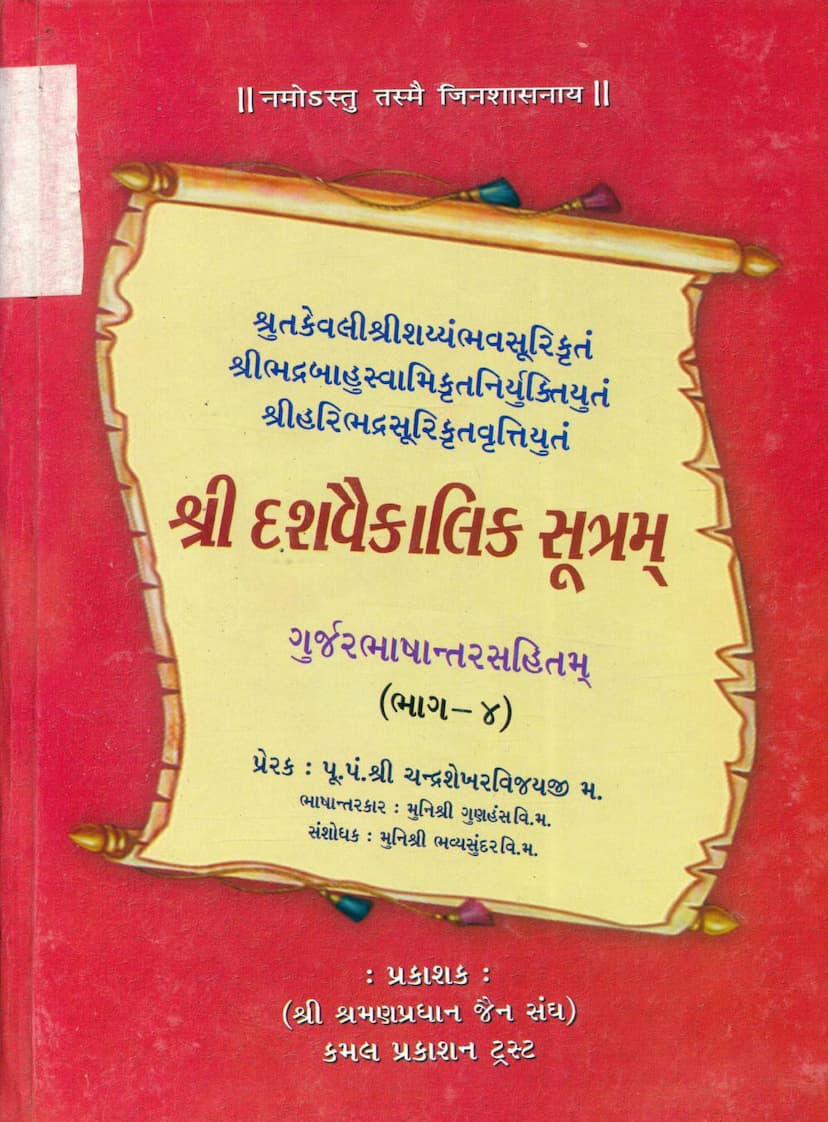Dashvaikalik Sutram Part 04
Added to library: September 1, 2025

Summary
This is a comprehensive summary of the provided Jain text, "Dashvaikalik Sutram Part 04," based on the given pages.
Book Title: Dashvaikalik Sutram Part 04 Author(s): Gunhansvijay, Bhavyasundarvijay Publisher: Kamal Prakashan Trust Catalog Link: https://jainqq.org/explore/005766/1
Overall Summary:
The provided text is the fourth part of the Dashvaikalik Sutram, a significant Jain scripture. This volume, in Gujarati with a Marathi translation, focuses on Chapters 8, 9, and 10, along with Chulikas 1 and 2. The work is enriched with commentaries by revered Jain scholars like Shrutkevali Shri Shyyambhav Suri, Shri Bhadrabahuswami, and Shri Haribhadra Suri. It is presented with the inspiration of Pujya Pandit Shri Chandrashekhar Vijayji M.S. and translated by Muni Shri Gunvansh Vijayji, with research by Muni Shri Bhavyasundar Vijayji.
The Dashvaikalik Sutram is described as a highly important scripture that is believed to endure until the end of the fifth era, lasting for 21,000 years. Its significance is highlighted by the fact that it was extracted from the fourteen Purvas by Shrutkevali Shri Shyyambhav Suri for the spiritual benefit of his son, Manak, who had only six months of life remaining. Studying this scripture is said to impart the essence of monastic life and ensure spiritual well-being.
The text emphasizes the profound teachings within its chapters, detailing the conduct and principles essential for Jain monks and nuns. It stresses the importance of adhering to specific practices before undertaking certain spiritual responsibilities, such as not performing 'Mahavrat Arohan' (Vadi Diksha) without understanding the four chapters with their meanings. Similarly, the fifth chapter, 'Pindeshana,' is crucial for the right to beg for alms, and the seventh chapter, 'Vakyashuddhi,' is vital for the authority to deliver discourses or even to speak. The verses are described as both precise and meaningful, essential for all ascetics to study, memorize, understand, and internalize.
The introduction by Muni Bhavyasundar Vijayji acknowledges the immense contribution of past scholars like Bhadrabahuswami and Haribhadrasuri for their commentaries (Niryukti, Churni, and Tikas) which make the profound teachings accessible. He notes that despite these efforts, the text can still be challenging for beginners due to the passage of time and the complexity of the language. The current translation into simple Gujarati aims to bridge this gap, making the scripture's profound wisdom available to a wider audience, especially those who may not have immediate access to learned gurus.
Key Themes and Content:
-
Chapter 8 (Achar Pranidhan): This chapter focuses on the importance of pranidhan (carefulness, mindfulness) in conduct. It discusses the distinction between dravya (material) and bhava (mental) pranidhan. It elaborates on controlling the senses and emotions (like anger, pride, deceit, greed) as crucial for spiritual progress. The chapter includes detailed instructions on avoiding harm to all living beings (six jiva kayas), with specific guidelines for interacting with elements like earth, water, fire, air, plants, and living beings. It also touches upon proper behavior regarding food, possessions, speech, and internal mental states. The importance of observing vichar (reflection) and understanding the impermanent nature of life is also stressed.
-
Chapter 9 (Vinay Samadhi): This chapter is dedicated to the significance of vinay (humility, respect) and samadhi (equanimity, concentration). It outlines various forms of vinay, including loka-upachar vinay (conventional respect), artha-vinay (respect for material gain), kama-vinay (respect for desire), bhaya-vinay (respect due to fear), and moksha-vinay (respect for the path to liberation). It explains how different types of vinay are practiced and their consequences. The text emphasizes the importance of vinay towards gurus and those with superior spiritual knowledge, highlighting that true spiritual progress is linked to respectful conduct. It also details the negative consequences of avinya (disrespect) and the virtues of vinay.
-
Chapter 10 (Sabhikshu): This chapter defines the characteristics of a sabhikshu (a true mendicant or monk). It distinguishes between dravya-bhikshu (material mendicant) and bhava-bhikshu (mentally mendicant). The text emphasizes that external appearances or mere begging do not constitute a true bhikshu. Instead, a true bhikshu is characterized by their internal state: controlling the senses, practicing mindfulness (pranidhan), adhering to the teachings of the Tirthankaras, abstaining from sinful actions, cultivating virtues like forgiveness and contentment, and engaging in svaadhyaya (self-study). The chapter also warns against actions that are detrimental to spiritual progress, such as attachment to worldly pleasures, disrespect towards gurus, and negative speech.
-
Chulikas 1 & 2 (Related Texts): These supplementary sections seem to delve into more specific aspects or nuances related to the main chapters. Chulika 1, "Ratipakhyan," appears to discuss the importance of avoiding attachment to worldly pleasures and maintaining equanimity, using the metaphor of the natural cycle of elements. Chulika 2, "Vivikta Charya," focuses on the principles of secluded conduct for ascetics, highlighting practices like avoiding crowded places, maintaining minimal possessions, speaking judiciously, and cultivating inner peace.
Important Notes and Instructions:
- The book explicitly states that this text is intended for the authorized readers, primarily monks and nuns (Sadhu-Sadhvi Bhagwanto). Laypersons (Grihasthas) are instructed not to read it to avoid karmic consequences (jnanavarniya-mohiya v. karma).
- Even monks and nuns are advised to study this under the guidance of learned gurus (Geetarth Gurubhagwanto).
- The text is presented not just for reading but for deep, systematic study, including memorization of verses and their meanings.
Overall Message:
The Dashvaikalik Sutram, as presented in this volume, is a practical guide for ascetics, offering profound insights into conduct, humility, mindfulness, and the true nature of monasticism. It underscores the necessity of internal purity, detachment, and unwavering devotion to spiritual principles for achieving liberation. The commentary and translation aim to make these timeless teachings accessible and applicable for contemporary ascetics.